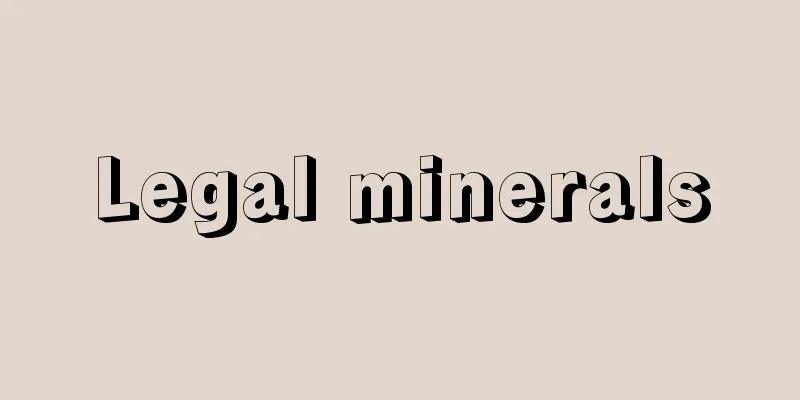Legal minerals

|
These minerals are subject to the Mining Act, and are also called minerals subject to the Mining Act. The Mining Act was established with the aim of contributing to the promotion of public welfare through the rational development of mineral resources. To that end, legal restrictions on their development are necessary, with the protection and effective use of mineral resources as the norm. The following 41 types of minerals are stipulated as legal minerals (Mining Act, Article 3, Paragraph 1). Gold ore, silver ore, copper ore, lead ore, bismuth ore, tin ore, antimony ore, mercury ore, zinc ore, iron ore, iron sulfide ore, chromite ore, manganese ore, tungsten ore, molybdenum ore, arsenic ore, nickel ore, cobalt ore, uranium ore, thorium ore, phosphate ore, graphite, coal, lignite, petroleum, asphalt, combustible natural gas, sulfur, gypsum, barite, alum, fluorite, asbestos, limestone, dolomite, silica stone, feldspar, azure stone, talc, fireclay (limited to those with a fire resistance of Seger cone number 31 or higher), and placer (gold sand, iron sand, tin sand, and other metallic ores that form alluvial deposits). The Mining Law also provides for the right to mine and acquire these minerals (mining rights). In order to explore and develop, a mining district must be legally established and approval from the government is required. Even if mineral resources are explored or discovered, they cannot be mined immediately. Minerals that are permitted to be mined under the Mining Law are limited to those that have economic value, even if they are legal minerals. Economic value is determined from a comprehensive perspective, including grade, reserves, difficulty of dressing, smelting, transportation, and mining, demand, and price. In addition, if the Pollution Adjustment Committee determines that mining of minerals is generally against the public interest or is inappropriate compared to agriculture, forestry, or other industries, mining is not permitted even if mineral resources exist (Article 15 of the Mining Law). Mining rights holders are required to pay mining district taxes. In addition, waste mines or slag of these minerals are also subject to the Mining Law as long as they contain legal minerals. In addition, the mining of minerals other than those designated by law is left to the discretion of the owner of the land. However, non-metallic resources such as bentonite, mica, acid clay, diatomaceous earth, and pottery stone are subject to the Crushed Stone Law in the same way as stone and crushed stone. [Hiroaki Kaneda] [Reference] |Source: Shogakukan Encyclopedia Nipponica About Encyclopedia Nipponica Information | Legend |
|
鉱業法の適用を受ける鉱物で、鉱業法適用鉱物ともいう。鉱業法は、鉱物資源の合理的開発によって公共の福祉増進へ寄与することを目的として定められている。そのために、鉱物資源の保護と有効活用を規範として、その開発の法的規制が必要となる。その対象となる鉱物が法定鉱物として、以下41種が規定されている(鉱業法第3条1項)。金鉱、銀鉱、銅鉱、鉛鉱、蒼鉛(そうえん)鉱、スズ鉱、アンチモン鉱、水銀鉱、亜鉛鉱、鉄鉱、硫化鉄鉱、クロム鉄鉱、マンガン鉱、タングステン鉱、モリブデン鉱、ヒ鉱、ニッケル鉱、コバルト鉱、ウラン鉱、トリウム鉱、リン鉱、黒鉛、石炭、亜炭、石油、アスファルト、可燃性天然ガス、硫黄(いおう)、石膏(せっこう)、重晶石、明礬(みょうばん)石、蛍石(ほたるいし)、石綿、石灰石、ドロマイト、珪石(けいせき)、長石、ろう石、滑石、耐火粘土(ゼーゲルコーン番号31以上の耐火度を有するものに限る)および砂鉱(砂金、砂鉄、砂スズその他沖積(ちゅうせき)鉱床をなす金属鉱をいう)。また、これらの鉱物を掘採・取得する権利(鉱業権)も鉱業法に定められている。探査・開発をするためには、法的に鉱区設定を申請し、国の承認を要する。また、鉱物資源を探査・発見しても、これらをただちに掘採することはできない。鉱業法の適用を受け、採掘が認められる鉱物は、法定鉱物でも経済価値のあるものに限られる。経済価値は、品位、埋蔵量、選鉱、製錬、運搬、採掘などの難易、需要、価格などの総合的見地から定められる。また、公害等調整委員会において、鉱物を掘採することが一般的に公益に反するかまたは農業、林業もしくはその他の産業と対比して適当でないとされたときは、鉱物資源が存在しても掘採することができない(鉱業法第15条)。鉱業権者には、鉱区税納付の義務が課せられる。また、これらの鉱物の廃鉱または鉱滓(こうさい)(スラグ)も、その中に法定鉱物を含む限りは鉱業法の適用を受ける。また、法定鉱物以外の鉱物の採掘は、その土地の所有権者に任されている。ただし、ベントナイト、雲母、酸性白土、珪藻土、陶石などの非金属資源は、石材や砕石と同様に砕石法の適用を受ける。 [金田博彰] [参照項目] |出典 小学館 日本大百科全書(ニッポニカ)日本大百科全書(ニッポニカ)について 情報 | 凡例 |
Recommend
Kashinreigetsu - May of the Year
Good days and good months. Happy days. Happy and j...
Land Tax Reform
The Meiji government implemented a reform of the ...
Belly - Belly
In biology, the word "ventral" has two ...
Osteon
Also called an osteon. A unit of compact bone that...
Acting Club
... It is made up of the various stage-related st...
Nao Deguchi - Nao Deguchi
Year of death: November 6, 1918 Year of birth: Tem...
Naudé, G.
…Under the reign of Louis XVI, the library double...
Capture of Nanjing - Nanjing Koryaku
This was a strategy used by the Japanese army to c...
Abalakov, EM - Abalakov
…The altitude was confirmed by surveying in 1932,...
Fujiwara no Michinaga
A politician in the mid-Heian period, he was at t...
Forced investigation - Kyouseisousa
A compulsory measure taken by an investigative ag...
Chancel (English spelling)
An architectural term, as opposed to the outer san...
Disappearing items
A prop that can only be used once on stage because...
Autopilot - Autopilot (English spelling)
Automatic piloting device. As aircraft become lar...
bear's foot
...The plant is propagated by division or seedlin...









